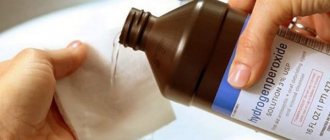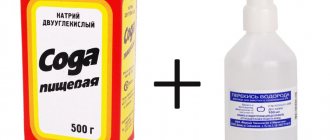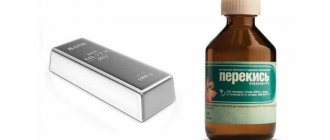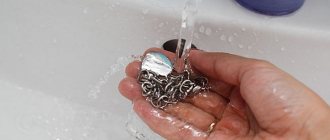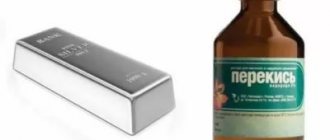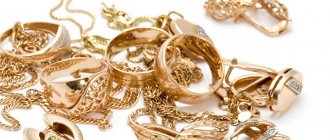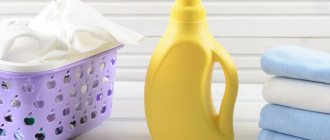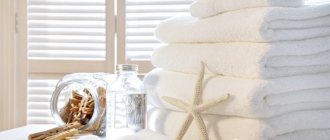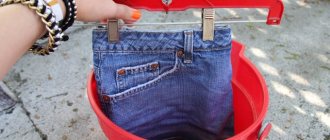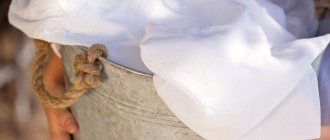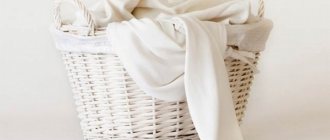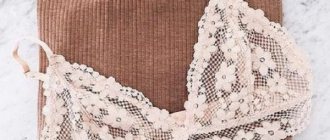Update date: 07/17/2020 15:13:23 6208 Share:
Author: Anastasia Berkovich
*Review of the best according to the editors of simplerule.ru. About the selection criteria. This material is subjective in nature, does not constitute advertising and does not serve as a purchase guide. Before purchasing, consultation with a specialist is required.
You can bleach laundry using hydrogen peroxide itself or with the addition of other products. Here's the basic way:
- Pour a bucket of warm water.
- Add hydrogen peroxide and mix well. For every liter of water you need to pour one teaspoon of the product.
- Place the laundry in the solution and leave for 20-30 minutes.
- Take the laundry out and run it under the tap for about a minute to rinse.
- Wring out the item and hang it to dry.
If stains remain on clothes after bleaching, they can be removed by combining hydrogen peroxide with baking soda. A solution of these two products helps to cope with stains no worse than factory stain removers. Follow these instructions exactly:
- Prepare a paste of baking soda and hydrogen peroxide. For 1 teaspoon of powder you will need 10 ml of product.
- Apply the mixture to the stains with a cotton pad and leave for 15 minutes.
- After processing, rinse the item well. The spots should disappear.
- Wring out the item and hang it to dry.
- If white curtains are not washed for a long time, they begin to turn gray under the influence of accumulating dust. To return them to their previous appearance:
- Pour 5 liters of warm water into a bucket or basin.
- Add a tablespoon of peroxide and a tablespoon of ammonia there.
- Soak the curtain in the solution and leave for half an hour.
- Rinse under running water.
- Wash your curtains as usual.
A solution of hydrogen peroxide, citric acid and soda ash will help deal with particularly difficult stains, such as greasy ones. Clean the item from excess contaminants and process as follows:
- Pour 2 liters of warm water into a bucket.
- Mix in it a teaspoon of hydrogen peroxide, a teaspoon of citric acid and a tablespoon of soda.
- Immerse your clothes in the resulting solution and leave for 15-20 minutes.
- Rub the stain. It should come off.
- Rinse the item thoroughly under water.
A mixture of hydrogen peroxide and dish soap also works well for oil and grease stains. This solution is easy to prepare and works well for cotton, but is not recommended for silk or wool:
- Pour 5 liters of warm water into a bucket.
- Add 2 tablespoons hydrogen peroxide and 1 tablespoon dish soap. Stir well.
- Immerse the laundry in the solution. Rub the stained area submerged in water to help the stain come off. Leave to soak for 15-20 minutes.
- After processing, rinse the item well. The spots should disappear.
- Wring out the item and hang it to dry.
You can also make your own stain remover using this recipe if there is no need to soak the entire item before washing. Simply mix peroxide and dish soap in the same ratio (the amount depends on how much solution you need). There are other recipes for hydrogen-based stain removers.
Advantages and disadvantages of hydrogen peroxide bleaching
Hydrogen peroxide is a universal fabric bleach. This product can be bought at any pharmacy. Bleaching fabric with hydrogen peroxide does not damage textile fibers. Suitable for delicate items made of silk and wool. When washing, only a three percent solution is used, which is diluted in the following ratio: 2 tablespoons of peroxide and ammonia per 10 liters of boiled water. The laundry is placed in the mixture for no more than 30 minutes, then washed in the usual way.
Thanks to this method, you can return clothes to their original snow-white appearance, which fades and turns gray over time. Traces from sweating, antiperspirant, and vegetable oil are eliminated.
Treating things with peroxide has a number of advantages:
- minimum cost;
- removal of old contaminants;
- ease of preparation of the mixture;
- economical use;
- preservation of material.
The effect of the drug is due to its direct effect on stains, saturating the tissue with oxygen and breaking down dirt.
Hydroperit tablets are suitable as an alternative. One tablet replaces a tablespoon of 3% hydrogen peroxide solution. The effect of the two drugs is the same, but hydroperite contains urea.
What and how to bleach yellowed white things?
Unfortunately, white things turn yellow over time. This is due to:
- frequent washing not in clean spring water, but in water in which various impurities are mixed
- natural human excretions
- remnants of protein deposits that eat into the fabric and give it such an unkempt appearance
To achieve relative whiteness of yellowed white things, you will need to carry out several cycles of the following procedure:
- wet a white item in cool water and leave it for several hours (remove any remaining protein that is removed in cool water)
- pour hot water onto the fabric, rub the item with laundry soap until foam forms. Leave it like that for another hour
- rinse several times
It is better to bleach a yellowed item with laundry soap.
In what cases can you bleach things with hydrogen peroxide?
Hydrogen peroxide is used in the following cases:
- Help in restoring color.
- Elimination of yellow spots on wool and silk products.
- Removing sweat stains.
When restoring the colors of a gray item, take a basin and pour hot water into it. For about 10 liters of liquid, add 2 tablespoons of ammonia and hydrogen peroxide. Soak the product for 30 minutes, wash as usual.
To bleach delicate fabrics, use the following mixture: dilute a tablespoon of washing powder for white fabrics with half a bucket of warm water, 4 tbsp. coarse table salt, 1 tbsp. ammonia, 1 tbsp. hydrogen peroxide. Mix the ingredients thoroughly, soak the items for 2 hours and rinse with water.
You can bleach yellow stains from cotton by directly applying a 3% solution to the stains, leave for 5 minutes and rinse. After drying, the procedure can be repeated.
- How to bleach towels at home without boiling
- How to wash roller blinds: secrets of gentle care
- This method will give your underwear a snow-white look.
How store products work
Manufacturers of washing powders or special bleaching agents for washing are inventing more and more new ways to achieve the whiteness of fabrics that are washed. It must be said that these products are quite effective, and many modern women enjoy using them. The result is good and impressive - snow-white shirts and other items of clothing and linen can be pleasing to the eye.
Store-bought products whiten things, but at the expense of aggressive chemicals.
IMPORTANT: The whole point is that manufacturers add special reflective particles to washing powders, thanks to which the effect of bright whiteness is achieved
- After all, all housewives are well aware that special powders for white linen and powders for colored fabrics are now on sale, designed to preserve their color
- So, for those who want to have white white, and colored clothes colored and not faded, advice: when purchasing, choose the appropriate laundry detergent and do not mix white clothes or linen with colored ones. Wash them separately
- And for those people who do not recognize modern chemical additives in washing powders and want to use the good old, as they consider, non-chemical agents, our advice
White items should be washed immediately.
IMPORTANT: In order for a white item not to be washed and look like new, you need to wash it on time, without storing it for later. Dirt, dust, sweat, etc. “eat into” the material, so that later it is difficult to remove them efficiently and achieve the original whiteness of the fabric
Review of popular methods and additions to peroxide
There are many different methods using hydrogen peroxide to bleach items that have a bleaching effect on a specific type of fabric. When choosing a method, it is important to correctly determine the type of material, select the washing mode and temperature.
For bleaching natural fabrics
You can bleach natural material in a gentle way using baking soda. To restore color, prepare the following mixture: add 2 tbsp to 5 liters of water. ammonia and 5 tbsp. soda First, soak the items for 4 hours and wash.
Soda ash, which is poured into the powder compartment of the washing machine, will help to bleach linen or cotton. Set the washing temperature to 70 degrees. When using this product, it is prohibited to add additional bleaching agents.
Before using aggressive methods, you need to try a simple product - baking soda paste. It is easy to dilute: dissolve a small amount of soda in water. Apply this mixture to the stain, rubbing it into the fabric with your fingers. Leave for 30 minutes and then wash. If no effect is observed, you can repeat the procedure.
A mixture of 10 ml of hydrogen peroxide and 1 tsp will help wash collars and shirt cuffs. soda Apply to contaminated areas and leave for 15 minutes. After the time has passed, wash off the mixture, wash and rinse the shirt well.
- What products should not be used to whiten underwear?
- Why wash new bedding?
- How to bleach laundry in a washing machine
Hydrosulfite, vinegar and nylon thread will help restore the whiteness of a down scarf. Take 10 liters of water at a temperature of 40-45 degrees, add 2 tbsp. hydrosulfite. Place the product in the basin for 20 minutes. We don’t three and we don’t pull. We wash it by hand, without dry cleaning - this harms the product and significantly shortens the life of the down scarf. Then rinse in warm and cold water with the addition of 2 tbsp. vinegar essence. After this, wring out the scarf and hang it on a line to dry.
For synthetics
Synthetic items: tulle, clothes and underwear made of polyester are bleached at low water temperatures. It is prohibited to use products that contain chlorine. Do not dry in direct sunlight. Polyester is bleached with salt: 600 g of table salt per 10 liters of water. Soak the items for 2 hours, then rinse.
Another way: ammonia with soda. The mixture is prepared at the rate of 2 tablespoons of ammonia, ten tablespoons of soda per 10 liters of water. Leave in the mixture for 3 hours, then wash.
You can whiten stains on jeans using lemon juice. Take 1 liter of water, add 1 tsp. citric acid and a tablespoon of lemon juice. Things are soaked, then rinsed and dried. The product can be sprayed using a spray bottle to lighten certain areas of the pant leg.
An effective way to quickly bleach any fabric is laundry soap and a plastic bag. Lather up the dirt and put the items in a bag, pack it tightly, leave for a day. Then we take it out and rinse.
Hand washing and soaking in hydrogen peroxide will get rid of unpleasant stains. To eliminate the unpleasant odor of peroxide, wash the product with the smelling powder.
Preparing your teeth
Since the whitening procedure is quite harmful to tooth enamel, before starting it, measures should be taken to minimize the likelihood of negative consequences.
First of all, visit a dentist who will determine the condition of your teeth and enamel. Any manipulations using peroxide can only be carried out by those people who have thick and fairly durable enamel.
The dentist will examine the teeth, identify areas with darkening and yellowing and determine the nature of their origin. If the yellowness is not outside, but inside the tooth, then peroxide will not give the expected whitening result.
Precautions when working with the substance
There are certain precautions when working with peroxide to avoid tissue damage:
- The soda mixture with peroxide is applied to the fabric for no more than 5 minutes.
- Do not soak delicate materials in hot water with peroxide.
- To enhance whitening, do not add commercial bleaches.
- Do not remove rust stains with peroxide to avoid ruining your clothes.
- Use only 3% product, 10% concentrate and higher - cause skin corrosion. In case of contact with skin, rinse immediately with plenty of water. If swelling and hyperemia persist, you should consult a doctor.
- Avoid splashing peroxide on mucous membranes, mouth and eyes to avoid chemical burns.
- Wash with rubber gloves in a ventilated area.
By following these recommendations, you will avoid unpleasant consequences of work. To avoid spoiling the material, try the folk remedy on a small area.
The article has been verified by the editors
How to bleach white things with white?
Only items made from natural fabrics (cotton, linen) are suitable for bleaching whiteness. Whiteness, as a product containing chlorine, is not suitable for synthetic and semi-synthetic fabrics. Also, chlorine-containing bleach thins the fabric, so it is not recommended to use it constantly.
Whiteness is recommended to be applied only to natural fabrics.
To bleach white items, it is better to add white to cool or slightly warm water.
Using aspirin to lighten tissue
A white T-shirt (shirt) has a gray tint due to frequent washing, but you don’t want to ruin your favorite item by bleaching it? Choose gentle methods, which include aspirin. The active ingredient is acetylsalicylic acid. It penetrates deep into the tissue, removes residual powders and concentrates.
How to use aspirin for whitening?
- Crush 5 tablets into powder. Dissolve in two liters of hot water.
- Soak a white T-shirt or shirt in the solution overnight.
- In the morning, wash the item by hand with regular soap or put it in a washing machine. You can add 2-3 more aspirin tablets to the washing powder. By the way, this method is suitable for preventing fabric tarnishing.
- Shake and leave the item to dry.
Use of mustard powder
Mustard is the best home remedy for removing grease stains from white clothes. Housewives use mustard powder to care for cotton tablecloths, towels, and kitchen curtains.
The procedure is as follows:
- Dissolve a bag of mustard powder in 5 liters of hot water.
- Leave things in the solution for 3 hours.
- Rinse with clean water to remove any traces of mustard and place in the washing machine.
- Dry white items.
How to bleach children's white clothes?
You need to be especially careful when bleaching children's clothes. Although there are now special hypoallergenic children's washing powders, all home remedies that are safe for children can still be used for bleaching. These include:
- salt
- potassium permanganate
- baking soda
- baby soap
- laundry soap
- lemon acid
- hydrogen peroxide
Things are pre-soaked in one of the mentioned products and left for a while.
Children's clothes can be bleached with baby soap grated and dissolved in water.
Things are then rinsed several times. This is followed by traditional washing and repeated rinsing again.
